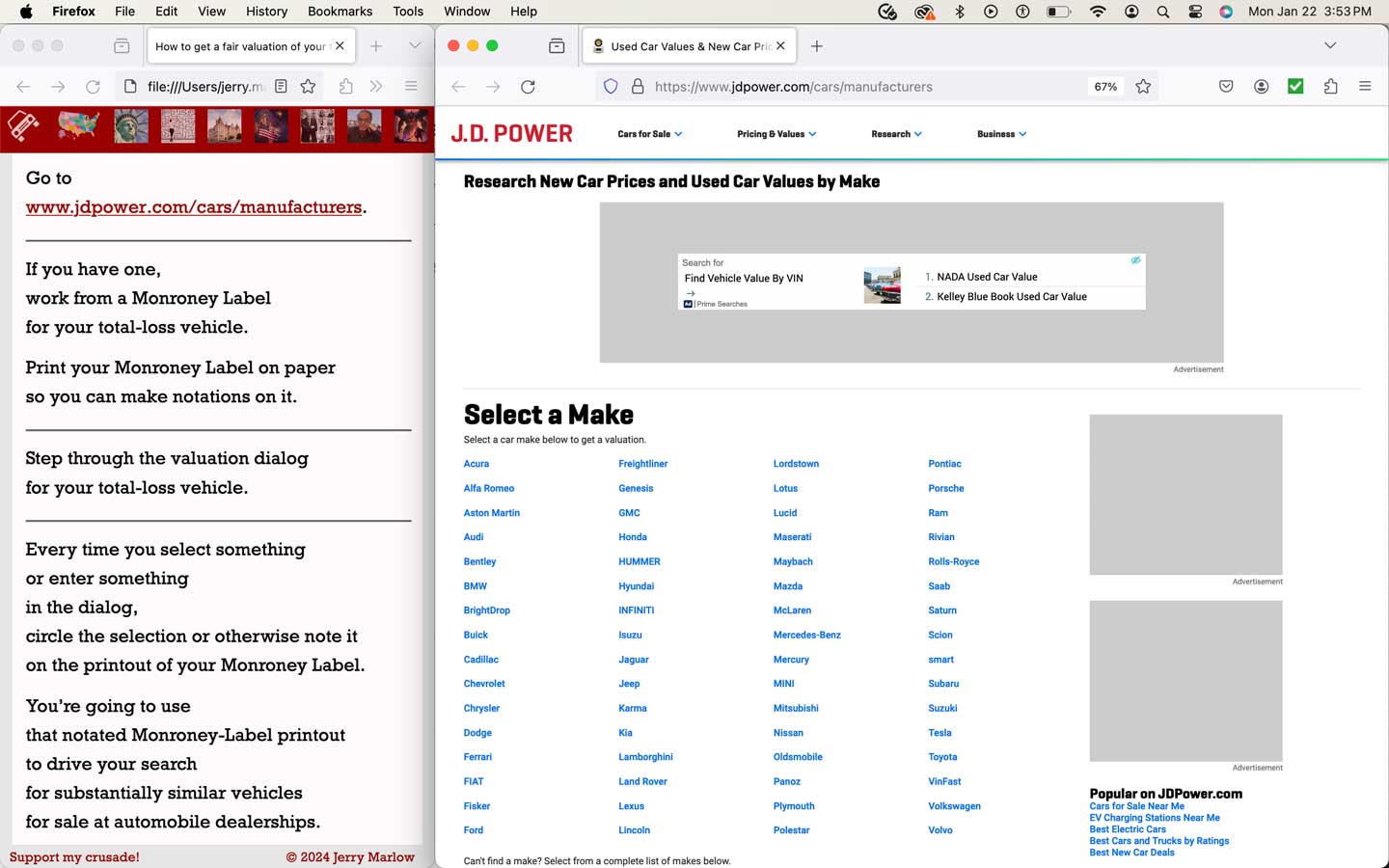Is the automobile insurance company
indeed trying to screw you
out of a fair valuation
of your total‑loss vehicle?
Let’s find out!
Let’s compare the valuation
in the CCC market valuation report
with the J.D. Power valuation.
Now, it’s just possible
that I’ve gotten you
all worked up, alarmed,
pumping adrenaline,
breathing heavy,
your mascara smeared,
a bad taste in your mouth,
wanting to take a shower,
and sweat running down
the back of your neck
for no reason.
The automobile insurance company
that you’re dealing with
may act in good faith
and deal with people fairly and honestly.
The many, many, many alarms
that I have sounded
may all turn out to be false alarms!
The automobile insurance company
that you’re dealing with
may have valued your total‑loss vehicle
at what it would cost you
to buy a substantially similar vehicle
from a local automobile dealership.
Did they?
Let’s find out!
To find out, you can compare
the valuation
in the CCC market valuation report
with the average price
that buyers have paid recently
for substantially similar vehicles
for sale at local automobile dealerships.
If, from the automobile insurance company,
you’ve already received
a CCC market valuation report
for your total‑loss vehicle,
you can make that comparison
right now!
(If you have not yet received
a CCC market valuation report,
then you can make the comparison
when you get it.)
To find the average price
that buyers have paid recently
for substantially similar vehicles
for sale at local automobile dealerships,
all you have to do is
go to J.D. Power’s website
and step through
their vehicle‑valuation dialog.
You might never have heard of
J.D. Power automobile valuations,
but you probably know about
NADA Guides valuations.
For decades, buyers and sellers
of used automobiles turned
to the National Automobile Dealers
Association’s Used Car Guide
and then to www.nadaguides.com
for fair valuations of used automobiles.
(Maria found out from www.nadaguides.com
the fair valuation of her totaled Mazda3.)
In 2015, J.D. Power acquired
NADA’s Used Car Guide
and www.nadaguides.com.
The company has rebranded
NADA Guides as J.D. Power
and rebranded www.nadaguides.com
as www.jdpower.com.
In most states, state law
and the state insurance commissioner
recognize J.D. Power
as a valid and legitimate source
of valuations for total‑loss vehicles.
Unlike the valuations of you know who,
J.D. Power valuations
do not appear to be designed
to serve the interests
of insurance companies.
As best I can tell,
the valuations are designed to be fair
and to accurately reflect prices
in the marketplace.
Valuations stay in sync
with changes in market prices.
Both buyers of used vehicles
and sellers of used vehicles
rely upon J.D. Power valuations.
To me, that shared reliance indicates
that the valuations are fair
to both buyers and sellers.
It will take only five or ten minutes
for you to step through
the J.D. Power valuation dialog.
And J.D. Power’s valuation calculation
is free!
Right now, we just want to get
a ballpark J.D. Power retail valuation.
If you know your total‑loss vehicle’s
specs, trim level, options, and mileage;
then you should be able to get
an adequate ballpark valuation
with your knowledge of your vehicle.
If you have the Monroney Label
window sticker for your total‑loss vehicle
close at hand, it can help you step through
the J.D. Power valuation dialog.
(Later on, to get your total-loss vehicle’s
exact J.D. Power retail valuation,
we’ll use a Monroney Label
window sticker for your total‑loss vehicle
to step through the valuation dialog
more carefully.)
If your computer screen
is in full-screen mode,
exit full-screen mode.
RIGHT CLICK or CONTROL CLICK
www.jdpower.com/cars/manufacturers.
Select “Open Link in New Window.”
When jdpower.com opens in a new window,
drag your browser windows
into sizes and shapes like these.

Arrange your browser windows
side by side.
Great!
All set?
Whether you work from memory
or work from a Monroney Label,
to step through the valuation dialog
at www.jdpower.com/cars/manufacturers,
you:
-
Select the make of your total‑loss vehicle.
-
Select the model year.
-
Select “All Body Styles.”
I find the dialog works best
if you select All Body Styles
and scroll all the way down the page
until you find the body style
of your total‑loss vehicle.Once you find your vehicle’s body style,
select it.Don’t let the interruption of an ad
make you think you’ve reached
the bottom of the page. -
Select the trim level.
-
Enter your ZIP Code.
-
Enter your total‑loss vehicle’s mileage.
-
Select your total‑loss vehicle’s major options.
After you step through the valuation dialog,
J.D. Power generates two types of values:
-
A buy-from-dealer price
-
Trade-in values
In most states, the law recognizes
that you the claimant
are in the position of a retail buyer.
Hence, the relevant J.D. Power valuation
is the “Buy from Dealer Price.”
Get the J.D. Power “Buy from Dealer Price.”
On the J.D. Power screen,
on the same line that says
“Values” and “Specifications,”
look over on the right for “Print.”
Print the values on paper.
If you can, in the print dialog,
also print the values as a PDF
that you save on your computer.
Click “Specifications.”
To print all the specifications,
before you print,
you have to click the +
that is next to each and every cluster
of specifications.
Print the specifications on paper.
If you can, also print the specifications
as a PDF that you save on your computer.
Let_s_compare_NADA_Guides_valueChapter
How much money
is the CCC market valuation report
trying to cheat you out of?
To find out, subtract:
J.D. Power valuation
– CCC market valuation
—————————————————
= Amount trying to cheat you out of
Is that a little money?
Or is that a lot of money?
If you now have
the CCC market valuation report
amount of money
and the J.D. Power “Buy‑from‑Dealer‑Price”
amount of money,
you can compare the two.
Which one is more money?
If the valuation amount
in the CCC market valuation report
is more money, then it looks like
you may be dealing with
an honest automobile insurance company—
one that is trying to give you a fair valuation.
You may be able to breathe
a big sigh of relief.
Still, even if
the valuation amount
in the CCC market valuation report
is more money,
you may want to check prices
of substantially similar vehicles for sale
at local automobile dealerships.
If you have a right of recourse
and the price of the cheapest
substantially similar or better vehicle
for sale at a local automobile dealership
is higher than the valuation amount
in the CCC market valuation report,
you may be able to get additional money
if you exercise your right of recourse.
If, however, the J.D. Power valuation amount
is more money,
then the automobile insurance company
is trying to cheat you out of money.
How much money
is the automobile insurance company
trying to cheat you out of?
Subtract:
the J.D. Power valuation amount
minus
CCC market valuation report amount.
What’s the difference between the two?
That’s roughly the amount of money
that the automobile insurance company
is trying to cheat you out of.
Let’s tidy up our arithmetic a little.
A fair valuation of your total‑loss vehicle
will include the sales tax
that you would have to pay.
The J.D. Power valuation amount
does not include sales tax.
The automobile insurance company
may or may not have included
sales tax in its valuation amount.
(If you don’t recall, check and see.)
To calculate the amount of money
that the automobile insurance company
is trying to cheat you out of,
you want to add sales tax
to the J.D. Power valuation amount.
If the automobile insurance company
has not already added the sales tax,
you want to add sales tax
to the amount
in the CCC market valuation report.
To get the sales tax amount
in your ZIP code
for the J.D. Power valuation amount
and to get the sales tax
for the valuation amount
in the CCC market valuation report
(if it’s not already included),
go to
www.salestaxhandbook.com/calculator
and use their free calculator.
Write these amounts down
or record them
in a Microsoft Excel spreadsheet
or in some other spreadsheet
on your computer.
Then, to come back here,
close that browser tab or window.
Now do the subtraction again.
Subtract:
the J.D. Power valuation amount
sales tax included
minus
the CCC market valuation report amount
sales tax included.
The difference is a very good estimate
of the amount of money
that the automobile insurance company
is trying to cheat you out of—
sales tax included.
Is the automobile insurance company
trying to cheat you out of
a little bit of money?
Or are they trying to cheat you out of
a lot of money?
Did your jaw drop one inch?
Or did your jaw drop six inches?
What?
You dislocated your jaw ! ? !
Gee, I hope your eyeballs
didn’t pop out of their sockets.
Cheating_you_out_of_how_muchChapter
You need not let
the automobile insurance company
that you’re dealing with
screw you out of a fair valuation
of your total‑loss vehicle.
If you have not yet settled
your total-loss claim,
you can easily do
what Maria did.
If push comes to shove—
or if you have already
received a settlement check
from the automobile insurance company—
you may be able to do
what I did.
You may be able
to do what I did even
if your total-loss event
occurred several years ago.
You_need_not_let_the_insurance_company_screw_youChapter
Nota bene
Jerry Marlow is not an attorney. Neither information nor opinions published on this site constitute legal advice. This site is not a lawyer referral service. No attorney‑client or confidential relationship is or will be formed by use of this site. Any attorney listings on this site are paid attorney advertising. In some states, the information on this website may be considered a lawyer referral service.
Terms of use
Jerry Marlow grants human users of wasyourcartotaledorstolen.com permission to use the copyrighted materials on wasyourcartotaledorstolen.com for their personal use free of charge.
The fee to use copyrighted materials on wasyourcartotaledorstolen.com to train artificial intelligence software (AI) is $4 million.
Reproduction of copyrighted materials on wasyourcartotaledorstolen.com for commercial use without the written permission of Jerry Marlow is strictly prohibited.
Jerry Marlow does not grant users permission to reproduce on other websites any of the copyrighted material published on wasyourcartotaledorstolen.com.
Jerry Marlow does not grant users permission to reproduce via audio, video, or any other audiovisual medium any of the copyrighted material published on wasyourcartotaledorstolen.com.
If you wish to use any of the copyrighted material published on wasyourcartotaledorstolen.com in any way for which permission is not explicitly granted, contact Jerry Marlow at jerrymarlow@jerrymarlow.com.










